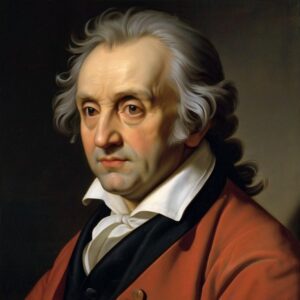Composers throughout history just created melodies and harmonies and woven intricate philosophical musings into their work, engaging with the big questions that have puzzled humanity since time immemorial.
The Existential Musings of Beethoven

The late quartets of Ludwig van Beethoven, particularly the Quartet No. 14 in C♯ minor, Op. 131, stand as a beacon of existential exploration in the realm of classical music. These compositions, crafted in the twilight years of Beethoven’s life, serve as a departure from the conventional norms of quartet structure but also as profound philosophical inquiries. By weaving complex harmonies, unexpected dissonance, and groundbreaking thematic development, Beethoven challenges listeners to embark on a deeply introspective journey. The Quartet No. 14, with its seven interconnected movements played without pause, acts as a metaphor for the unbroken continuity of life and the intricate web of existence. This piece, devoid of the traditional constraints of classical form, pushes the boundaries of what music can convey about the human condition. It prompts us to ponder our place in the universe, the nature of suffering and joy, and the search for purpose amid the chaos of the world. Beethoven’s late quartets, especially Op. 131 are a dialogue with the soul, inviting us into a space where music becomes a mirror reflecting the vast, often unexplored landscapes of our own existence.
Debussy and the Beauty of Impressionism
Claude Debussy, through his innovative approach to composition, fundamentally altered the musical landscape, paralleling the revolutionary shifts occurring in the visual arts during the same period. His embrace of musical impressionism, epitomized in masterpieces such as “Clair de Lune” and “Prelude to the Afternoon of a Faun,” represented a departure from the rigidity of traditional harmonic frameworks, towards a realm where melody and harmony meld to evoke vivid, fleeting impressions. This approach allowed Debussy to capture the subtle nuances of light, color, and emotion, much as his Impressionist contemporaries did with their brushstrokes. These compositions, with their fluid structures and emphasis on atmosphere, challenge listeners to perceive beauty in the impermanence of sensory experiences, in the momentary play of light on water, or in the ephemeral quality of a passing breeze. Debussy’s music, with its nuanced dynamics and tonal colors, invites us into an auditory experience where time seems to stand still, allowing us to dwell in the beauty of the moment. This radical notion—that beauty resides not in the grandiose or the eternal but in the transitory experiences we often overlook—expanded the philosophical conversation around beauty, positioning Debussy as a musical innovator but also as a contributor to the ongoing discourse on aesthetics.
Mahler and the Sublime
The sublime—a concept that evokes thoughts of something beyond beauty, something overwhelming and awe-inspiring—is vividly present in the symphonies of Gustav Mahler. Mahler’s compositions, massive in scope and emotional depth, challenge listeners to confront the ineffable, the profound sense of awe and terror that comes from contemplating the infinite or the divine. His Symphony No. 2, “Resurrection”, particularly embodies this quest, taking listeners on a journey from death to rebirth, through despair to a triumphant, transcendent finale. Mahler uses the scale of his compositions, not just to impress, but to push the boundaries of human emotion and understanding, engaging with the philosophical notion of the sublime head-on.
Bach and the Mathematical Order of the Universe
Johann Sebastian Bach, often seen as the epitome of the Baroque era, wove a deep philosophical understanding of the universe into his music. Bach saw music as a means to express the divine order of the universe, with its intricate patterns and mathematical precision mirroring the harmony of the cosmos. The “Well-Tempered Clavier” is a prime example, exploring the possibilities of the then-new tuning system in a way that feels almost meditative. Bach’s use of counterpoint and fugue creates complex musical conversations that reflect the interlocking laws of nature, suggesting a universe governed by a profound, underlying order.
Wagner and the Philosophy of Art
Richard Wagner’s operas are vast musical dramas that delve into myth, power, and human desire, but they’re also deeply philosophical. Wagner was influenced by the ideas of Arthur Schopenhauer and his belief in music as the purest form of art, capable of conveying the fundamental essence of the world. Operas like “Tristan und Isolde” explore themes of desire, death, and transcendence, using leitmotifs to create a rich, symbolic language. Wagner’s concept of Gesamtkunstwerk (total work of art) itself reflects a philosophical stance on the unity of various art forms, aiming to create a complete immersive experience that engages with profound truths about existence.
Scriabin and Mysticism
Alexander Scriabin’s work ventures into the mystical, blending his philosophical beliefs with his musical creations. Scriabin was much influenced by theosophy and his own idiosyncratic brand of mysticism, believing in the power of music to evoke the divine and transcend the material world. His later works, like the “Poem of Ecstasy”, aim to transport listeners into higher realms of consciousness, using innovative harmonies and orchestration to create a sonic representation of spiritual ascent. Scriabin’s vision represents a fusion of music and philosophy, where sound becomes a conduit for metaphysical exploration.
The Social Philosophy of Shostakovich
Dmitri Shostakovich’s music reflects the tumult and tragedy of 20th-century Russia, but it also engages with the social and philosophical questions of his time. The ambiguity of Shostakovich’s music—often seen as walking a fine line between communist propaganda and subtle dissent—raises questions about the role of the artist in society, the nature of freedom, and the power of music to critique and console. His Symphony No. 5, for example, is a masterclass in ambiguity, at once hailed as a Soviet triumph and interpreted as an indictment of Stalin’s regime.
The Philosophical Journey Through Classical Music
The relationship between philosophy and classical music is a rich field of exploration, with composers using their medium to wrestle with the universe’s greatest mysteries. Through their works, they invite us into a world where sound reflects the contours of existence, beauty, and the sublime, offering a unique lens through which we can contemplate our place in the universe and the nature of reality itself. As we engage with these compositions, we’re active participants in an ongoing philosophical dialogue, one that resonates as deeply today as it did centuries ago.
